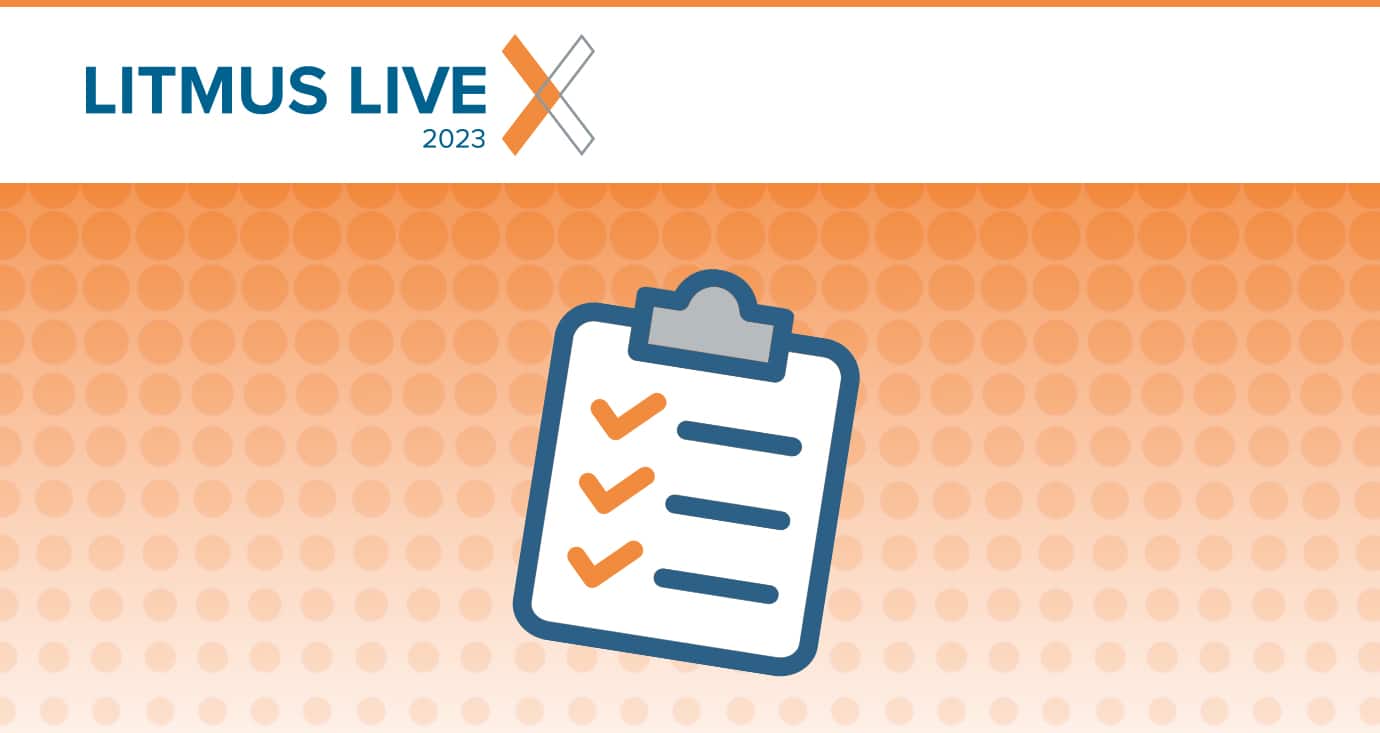Welcome to Litmus Live Behind the Scenes, where each month leading up to the conference we’ll dig in to some of the work we’re doing to prepare for Litmus Live, and shine some light on how we make the conference happen.
In this blog post, you’ll discover how we went about creating our Litmus Live 2023 agenda and selecting our (if I may say so myself) magnificent speaker lineup.
It all starts with a spreadsheet
As with many projects, creating the agenda started with me staring at a blank spreadsheet and wondering what I was doing. I had sections marked for the days of the conference, and had to decide how to break up the schedule into session-sized chunks, which would then set the limit on how many speakers we could comfortably select.
For years we’ve planned for thirty-minute sessions, which strikes us as a nice balance between enough space to dig into a topic, the average length of peoples’ attention spans, and our desire to pack in a ton of great content for our attendees. Once I’d marked off time for meals, worked in plenty of restroom and snack breaks, and added Litmus Live traditions like Live Email Optimization and 1:1 Speaker Q&As, I was left with twenty-six pristine timeslots spread over the two days of the conference, ready to have their speaker assigned.
Deciding on content tracks
Traditionally, Litmus Live sessions are broken up into marketer and developer tracks, with design content usually split betwixt them. This year, as I was beginning to review speaker submissions, I saw an emergent theme of talks that didn’t fit neatly into any of the categories above and that seemed to be derived from lived experience in this industry.
I started thinking of the two tracks as the work itself—strategizing, writing, designing, developing and testing email, and the work behind the work—navigating career growth, learning to build trust with other teams and get buy-in from internal stakeholders, process improvement, and planning for team changes. Our own email designer, Hannah Tiner, was the one who came my rescue with the much pithier titles Practical and Professional to describe the two thematic tracks.
At Litmus Live, we will always have eminently practical how-to sessions—that’s been the core of our content for years. As we grow as a community, though, it seems so necessary to also pass along the earned professional wisdom of people who’ve been in our industry for some time, to help the next generations of email geeks find their way with less difficulty. Every community needs its elders, even if they’re not that old.
Selecting the speakers
Reviewing speaker submissions is a treat. Reading your pitches, watching your videos—it’s all so energizing to take in. We had, at final count, eighty-eight submissions this year! Of course, with only twenty-six speaking slots available (which quickly became twenty-three after we signed a few sponsors) a fair amount of careful winnowing had to happen.
I started by grouping them topically, to see where we had similarity in the content being covered, and then categorizing them all thematically under the two content tracks to see roughly how many we had on each side. If the pitch seemd a little unclear on actionability, or perhaps a little too broad in scope, I’d gently set it aside. Where there was clear topic overlap, I’d also bring into consideration whether the speaker had more or less experience. We actually want a mix of greener and more seasoned speakers, as Litmus Live has long been a place where newer speakers—like I was once—can be encouraged to grow.
One key rubric I wanted to bring to the agenda as a whole was thinking about representation. Unsurprisingly, there are groups of people who have historically been underrepresented in these spaces—or to put it another way, it’s never been difficult to find speakers at martech conferences who look like me. It matters, who we see on that stage. We want Litmus Live to be representative of our wonderful and diverse email geeks community, and want to create a space where everyone can see themselves reflected in the spotlight. We hope that this year’s agenda is a step towards that reality.
What’s next with Litmus Live
Now that the agenda is out, we’re hard at work on the logistics of the physical conference space, the look and feel of it and the feeding and care of attendees, which we’ll dive into in a future Litmus Live Behind the Scenes post.
Are you trying to get buy-in for attending? We’ve got you covered with our downloadable guide Justify Your Litmus Live to help you frame your arguments and make your case to attend. We can’t wait to see you in Boston (or virtually) from September 11th-13th.
Ready to get your ticket? You can purchase it on our Litmus Live registration page.
The post Litmus Live Behind the Scenes: Crafting the Agenda appeared first on Litmus.

